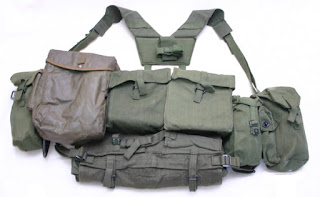Some armies define a soldier’s combat equipment as being three levels. This paper gives a concise account of the British Army’s perception:
- Assault Order, to provide for operations lasting a few hours. Items needed to “close and defeat an enemy then hold off his immediate counter attack. Weapons, ammunition, water and digging tools”. NBC equipment, communication gear, a flashlight and immediate first aid (field dressings) might also be included here.
- Combat Order for operations of 24hrs/ overnight. Assault order with some food and “just enough clothing to keep warm and dry”. This level might include some provision for sleeping in reasonable comfort.
- Marching Order, containing “all of the man’s issued items that he had in the field.” Some armies have had some very odd ideas what should be in this catergory! The wehrmacht infantryman took to the field with his best shoes and sports kit in his pack. At least this pack was carried on the company wagon.
To the above list I would add a fourth level, the Emergency Order. These are the things you have in your pockets that will be available if your webbing is lost. See my post on “sundries” for suggestions in this direction.
Theory and practice often diverge! For most British soldiers in the last quarter of the 20th century there was no real distinction between Assault order and Combat order. (For clarity I am using photos of the 58 pattern webbing. More recent systems use the same design.) Many of the “Combat Order” items were carried in the kidney pouches and poncho roll. These also carried not so vital items such as boot polish! The weight of the webbing with the kidney pouches and contents necessitates that the yoke be more thickly padded and this can interfere with the wearing of some rucksacs. The kidney pouches could not be easily removed from the webbing, so the infantryman went into the assault carrying a significant weight of equipment he did not immediately need. During one assault in the Falklands paratroopers discarded all of their webbing and carried ammunition in their pockets!
The kidney pouches also caused considerable problems with the design of military rucksacs. A good rucksac puts most of the weight on the top of your pelvis. It may have a hip belt to facilitate this. The main function of the shoulder straps is to keep the load in position. Kidney pouches or similar items hinder this. While British army designed rucksacs may resemble civilian models they behave quite differently.
In a recent post we looked at the Vietnam chest rig. This, combined with the grenade carrier and waterbottle on the belt is obviously an Assault order. Marching order was created by adding a rucksac and it will be noted that there is nothing at the back of the belt to hinder a comfortable fit. Note also that the shoulder straps of the chest rig are relatively unpadded too. The NVA soldier does not appear to have a formal means of “Combat Order” but obviously such an intermediate level of load is desirable. See my article on Soldier's sundries. Likely contents might include:
- Compact wash kit and repair kit
- Toilet paper
- Spare socks
- Canteen cup and brew kit
- One or two days rations
- Poncho/ basha
- Sleeping bag/ blanket/ poncho liner
- Poles and pegs
- Ground cloth/ kip mat/ airbed/ hammock.
- Hat(s), gloves.
- Rope
Some of the popular designs of civilian rucksac that have been used by British soldiers have detachable side pockets which can be joined together to create a small pack. The British Army committees in this paper regarded this as an acceptable way to carry loads of less than full Marching Order. Sadly they did not follow on to the logical step of eliminating the kidney pouches.
A pack formed from a pair of side pockets has a capacity of about 20-30 litres. It can easily accommodate the contents of a pair of kidney pouches. They are long enough to hold shelter pole sections. Some lightweight sleeping bags pack down to a rugby ball-sized mass so it is quite possible room for such a sleeping bag can be found inside such a pouch. If a number of accessory patches are fitted to the outside of the pouches items such as groundcloths, blankets, ponchos and kipmats can be tied under, around and between the two pouches. A mesh pocket would allow a towel or poncho to dry.
Such an approach eliminates the need for kidney pouches. It allows the use of more efficient rucksacs for marching order and gives the soldier a true, lighter assault order.
If you have enjoyed this article or it has been helpful to you please feel free to show your appreciation. Thank you.
The Books










